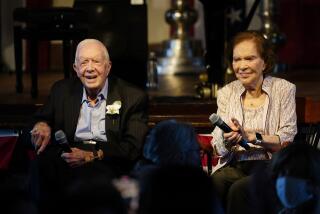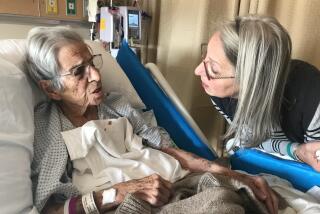Hospices Deal in Life, Mediate With Death : In Growing Numbers, Supplement to Hospitals Offer Compassion, Not Cure
- Share via
Eight people were standing around Betty Doebel’s bed, trying to figure out how to move her to a stretcher without breaking any bones.
The hospice team had been anxiously rehearsing this moment for weeks, ever since Doebel had decided she wanted to go back home to the Pennsylvania hills to die.
Inoperable cancer had spread throughout her body, including her skeleton. Her bones were so brittle with cancer that one day last August, as the nurses were turning her in bed, her left thigh bone crumbled. The leg was now in traction, a 10-pound sandbag dangling from the foot of her bed to hold the bone fragments more or less in place and keep them from rubbing against each other. The slightest pressure on her leg was excruciating.
And now the hospice team was about to try to transfer her onto a stretcher and into an ambulance for a 127-mile drive to a Bedford, Pa., hospital near her childhood home.
View the Mountains
No one knew exactly how much time Doebel had left, but it was probably not more than a few months. At 54, after nearly 30 years in the Washington area, what she wanted most was to move back home.
“She said she wanted to go back to the farm and look out the window at the mountains,” said her husband, Leo. “OK, lady, whatever you want.”
Doebel knew the risk. She had been warned she might not survive the journey. The motion and stress could dislodge a potentially fatal blood clot or throw her blood calcium out of whack. Sheer pain could send her into shock.
“I’m facing the unknown,” she said. “I don’t know what’s going to happen.”
For Leo Doebel, pacing outside her room, the course was simple. “We’ll just get a whole bunch of people and all pull together, and pray.”
While Betty Doebel closed her eyes and tried to forget what was happening, the team of eight fashioned her bed sheet into a kind of hammock and slide-lifted her ever so gingerly onto the blue foam “egg-carton” mattress on the stretcher alongside her bed.
It worked. A cheer--more relief than exultation--rose in the room. Doebel opened her eyes, smiled, closed them again.
Steadied by Sandbags
They wheeled her down the hall, interrupted by farewells from the hospice staff and other patients, and out into the sunshine. Two ambulance attendants lifted the stretcher into the back of the van.
Eyes shut against the glare and pain and fear of pain, Doebel lay motionless on a kind of nest, her stretcher and foam mattress buttressed by sandbags. Her stuffed white rabbit, Snuggles, rested by her left shoulder, and an automatic pump the size of a cigarette pack fed continuous morphine directly into her bloodstream through a tube in her chest.
Doebel’s hospice nurse, Norah David, climbed into the back of the ambulance. It was her day off, but missing this trip was unthinkable. She made sure they had everything: X-rays, medicines, six extra pillows, apple juice, crackers, lollipops, a trash bag. The ambulance pulled out, Leo following in the family Ford.
On a beautiful bittersweet fallish day, Betty Doebel was going home.
The term “hospice” derives from a medieval word for a wayside shelter for travelers on difficult journeys. The Oxford English Dictionary defines it as “a house of rest” for pilgrims, travelers, the destitute or the sick.
The word has come to mean a place or way of caring for the terminally ill and their families. Modern-day hospices are modeled on St. Christopher’s in London, founded in 1967.
Hospices do not use extraordinary medical means such as blood transfusions or an artificial respirator to treat a dying patient when prolonging life would merely prolong the patient’s death. When death occurs, there is no attempt to revive the patient.
The first hospice in the United States, Connecticut Hospice Inc. in New Haven, was founded in 1974. Now there are an estimated 1,500 hospice programs throughout the country in various stages of development, including about 1,000 already open. More than 100,000 Americans received hospice care last year, according to the National Consumers League.
Hospice of Northern Virginia, Betty Doebel’s way station on her journey home, was founded in 1977 and is the largest of nearly a dozen hospices in the Washington area.
Some hospices are based within hospitals; others offer exclusively home care through a visiting-nurse service. Still others, like Hospice of Northern Virginia, are free-standing programs that provide both home care and inpatient care.
Death as Part of Life
What they share is a commitment to viewing death as an integral part of life and to improving the care of dying patients for whom medical cure is no longer a realistic possibility.
Hospices are not for everyone, and they have no monopoly on compassionate care of the gravely ill. They are intended to supplement conventional hospital care, not to supplant it.
More than a place, hospice is an approach to care that, whenever possible, takes place in the home. It’s a team effort, beginning with the patients themselves and their families. The care team also includes nurses, doctors, social workers, clergy, dietitians, bereavement counselors and volunteers.
A hospice, says the National Hospice Organization, is “a program of palliative and supportive services which provides physical, psychological, social and spiritual care for dying persons and their families.”
The emphasis is on relief rather than resuscitation, comfort rather than cure. Day-to-day nursing care in a hospice consists of trying to control and relieve symptoms such as pain, nausea, incontinence, fever, bedsores, itching and shortness of breath.
What hospice is not about is euthanasia, or so-called mercy killing.
“Hospice affirms life,” the NHO’s national standards state. “Hospice neither hastens nor postpones death.”
“Yes, we’re working with people who are dying,” said Nell Worrall, who retired last year as assistant administrator of Hospice of Northern Virginia. “But we’re helping them live.”
Names of Towns Recited
After the ambulance crossed the border into Pennsylvania, Norah David, Betty Doebel’s nurse, would call out the names of towns they passed, so Doebel knew exactly where she was.
About 30 minutes outside of Bedford, in preparation for the transfer back to a hospital bed, David raised the intravenous dose of morphine from the automatic pump and gave Doebel two extra tablets of morphine under the tongue.
Again it took a crowd of attendants to lift her from one bed to another without breaking any of her brittle bones. As she had done that morning, Doebel kept her eyes closed, did her breathing exercises and tried to visualize pleasant places to distract herself from the pain. She imagined mountains, or a brook.
“The day they put her in traction,” recalled David, “Betty and I ‘went’ to the mountains and sat in front of the fireplace. I gave her a strawberry margarita, and we played gin.”
A family’s first contact with Hospice of Northern Virginia is often a telephone conversation with either Jo Turner or Mary Eileen Ness, whose desks face each other in the admissions office.
Like many of their colleagues, they came to hospice out of personal experience. Ness’ home was a kind of hospice before she had ever been to one. Her 6-year-old son Jason died of leukemia in 1983, after 11 months of home care, interrupted by hospital stays.
“I was hospice material, I guess,” says Ness, who joined Hospice of Northern Virginia as a volunteer after Jason died at home, and now is assistant admissions director.
Turner in recent years has watched her mother and only brother face cancer. All four of her grandparents and her father died of cancer, and Turner saw how they were cared for, the good and the bad, and how they died. Four years ago she decided to go to work at a hospice.
“Making friends with cancer is probably not a good way to put it,” she says, “but it’s something like that.”
Falling Through the Cracks
Turner and Ness see their job as one of trying to keep often-desperate people from falling through the cracks. It’s not the ones you admit, Turner’s predecessor told her when she took the job, it’s the ones you can’t help that will drive you crazy.
“I was very naive,” Turner says. “I always thought that when there was a death in the family, the family would rally around and pull together and sing ‘Blessed Be the Ties that Bind’ or something.”
Now she knows how rare that is: “The drinkers will drink more. The drug abusers will abuse, and all the anger comes out. All the problems are accentuated.”
A man calls. His aunt is dying of cancer. In a calm, deliberate voice, Turner explains to him that patients admitted to the hospice program must have a life expectancy of six months or less and must have exhausted the possibilities of curative medical treatment. She outlines home-care services, insurance coverage, Medicare rules. There are long pauses while she lets the man talk.
“People are sometimes afraid that hospice means giving up,” she says. “We try to tell people that we’ll help them keep as much control as possible. Hospice doesn’t mean giving up hope, it means hope for the best life possible in the time that’s left.”
Still, it’s never an easy decision for either patient or family.
“Are you a little bit nervous about thinking about doing this?” she asks the caller. She listens to his answer. “Uh-huh,” she says. “It’s good to have that feeling.”
Each of the hospice teams--home care and inpatient--gathers twice a week in the library, lugging thick green loose-leaf binders containing patient records. The teams go over every patient, one by one, discussing progress, problems, what can be done.
There are no easy cases.
A 32-year-old woman, divorced with three children, is dying of breast cancer six months after she nursed her mother to her death from ALS, or Lou Gehrig’s disease. A 30-year-old woman with multiple cancer has a 3-year-old child and a husband who’s an alcoholic and steals her drugs.
The discussion is by turns emotional and mundane. There are triumphs (“Bill’s going home tomorrow!”) among the talk of dressing changes, bowel movements, narcotic drug doses.
See His Dog
Small questions loom large. A 77-year-old man wishes to see his dog before he dies. A woman with just days left requests a trapeze over her bed so she can keep doing her exercises. Someone else wants to take Communion every day. A young woman in the final stages of breast cancer refuses to take oral medication, juice or even water because she’s afraid it’s a trick to keep her alive beyond her time.
A man dying of AIDS wants an ice cream cake for his birthday, but he may not survive until then. Should the staff surprise him with an early party, or will that only frighten him more?
The last Wednesday of every month, in the hospice lounge, Chaplain Jeanne Brenneis holds a nondenominational memorial service for the patients who have died in the previous month.
It’s a simple service, informal and brief, open to anyone who wants to attend: nurses, other staff members, families, patients.
“We have so many deaths in a month that we need time to remember these people as individuals,” Brenneis says. “This is a way to remember that these people didn’t just pass--they meant something to us.”
They remembered Tom, an AIDS patient who earlier in the summer watched a friend die of AIDS at the hospice, and who died at home, with as many care providers as any patient his nurse had seen.
Brenneis played a recording of “On Eagles’ Wings,” and said another prayer.
“We pray for the people we have cried with, and some we have fought with, for the people we have tried to help, and some we couldn’t help as much as we wanted to.”
For the patients, she prayed for “rest and sleep when they need it and freedom from pain.”
And for the hospice staff: “Help us remember, especially when we’re tired or angry or sad, or think perhaps we shouldn’t be in this line of work at all, to keep compassion in our hearts and tenderness in our hands.”
The savings under hospice care are greatest when patients are cared for at home. A nationwide study of 26 hospices found that over the last year of a patient’s life, hospital-based hospices saved $585 per patient and home-based hospices saved $2,221 per patient, compared with usual care.
In a study last year by Blue Cross and Blue Shield of Maine, the cost of hospice care averaged $52.77 per day at home and $182.99 per inpatient day, compared with an average daily hospital charge of nearly $600.
Sixty-five of the 78 Blue Cross-Blue Shield plans in the nation cover hospice care, but coverage varies from plan to plan.
Coverage Varies
Though the trend among insurance companies is toward greater coverage of hospice care, says Dale Lupu, assistant administrator of Hospice of Northern Virginia, benefits vary from “incredibly limited” to “open-ended.”
Medicare began covering hospice care in 1983 and now reimburses hospices for most kinds of care offered, including drugs, for up to 210 days. But Lupu says the reimbursement rates--about $69 a day for home care and $309 for inpatient care at Hospice of Northern Virginia--aren’t high enough to cover hospice costs.
The hospice loses an average of $1,400 on every Medicare patient cared for, she said. Sixty percent of the hospice’s patients are covered by Medicare.
For information about hospices write the National Hospice Organization, 1901 N. Fort Myer Drive, Suite 307, Arlington, Va. 22209.
More to Read
Sign up for Essential California
The most important California stories and recommendations in your inbox every morning.
You may occasionally receive promotional content from the Los Angeles Times.










